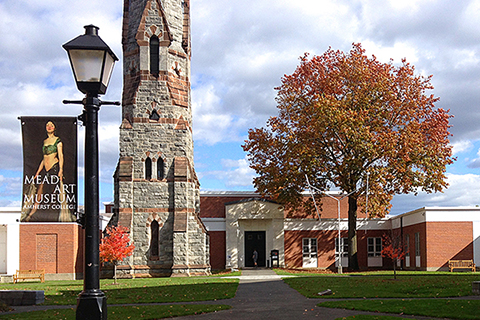

The Mead Art Museum showcased two of its newest exhibitions on Oct. 3: “Images of the Unimaginable: Art from the First World War,” and “Paper Landscapes: Prints of the American City and Countryside, 1820-1920.” Earlier this year, the museum debuted another exhibition: “Pain’s Pyrotechnic Spectacle: The Sino-Japanese War in Print.” All three display never-before-seen items from the Mead’s hidden holdings and show the versatility of the print medium and the different techniques of printmaking in various cultures, including Japanese war prints, American landscape prints and Russian avant-garde prints.
The largest of the three exhibits is “Images of the Unimaginable,” which commemorates the experiences of the First World War through four elements of stationary: prints, postcards, woodcuts and propaganda posters. The print series was discovered by Bettina Jungen while searching through the Mead’s 14,000 item collection in storage. Jungen wanted a reason to showcase the Mead’s extensive collection of prints by Natalia Goncharova, a famous avant-garde artist of the early 20th century, along with Olga Rozanova’s rare and cherished collection of line cuts. The exhibition also highlighted postcards and letters sent by American artists and soldiers Childe Hassam and Waldo Pierce, which contained grueling images of the war from the front lines. Additionally, the Mead contains American artist George Bellows’ response to the war in a series of prints inspired by invading British war propaganda. The exhibition also contains the intellectual work of Swiss painter and artist Félix Vallotton who, like Bellows, made art concerned with the Great War. Framing the collection are propaganda posters and photographs taken by Amherst College’s own soldiers in the ambulance corps, on loan from the Archives and Special Collections.
“The collection shows the involvement of the artists, who are a very specific group in society, who reflect on what’s going on [in the world] with more or less critical distance,” said Jungen, who curated the exhibition. The result is an emotional spectacle from many perspectives and visions of the suffering caused by the Great War.
The “Paper Landscapes” exhibition shows visions of a more peaceful time in a more peaceful place: America from 1820 to 1920. Georgia Burnhill found these prints during her Mellon Faculty Seminar in the Mead’s extensive hidden holdings. The centerpiece of the exhibit, which depicts the port of New York in its 19th-century glory, is complimented by the wide array of American landscapes in the exhibition, including Amherst itself. Many of the prints have not been shown on display before, including the aforementioned New York by Charles Mottram (1855), which had to be carefully prepared before going on display. The exhibit represents American printmaking as an art of its own.
A fourth grade tour group did not believe it when they visited the Mead last Friday, but they left appreciating the prints a bit more. One girl elegantly summarized the exhibit with a simple question: “Oh, so they’re not fakes?”
No, they are not fakes, and neither are the prints of the third exhibit of the third showcase: “Pain’s Pyrotechnic Spectacle: The Sino-Japanese War in Print.” Bradley Bailey, the E. Rhodes and Leona B. Carpenter Postdoctoral Curatorial Teaching Fellow in Japanese Prints, was digging through the collections and found an album in pristine condition that had never been shown before. Due to the album’s delicate state and exemplary condition, Bailey determined that the album could be displayed but not touched; taking the work apart would only harm the prints and dim the colors, which would lessen the impact of these finely preserved examples of Japanese prints.
Bradley described the prints as, “some of the best I’ve ever seen.”
Bradley and the Mead also collaborated with The Hampshire College Institute of Curatorial Practice in order to transfer the prints into a digital medium, making them accessible to the general public through the Five College Digital Humanities website.
The standards were high for the prints that could be displayed on the walls of the exhibition were high.
“We chose the ones that showcase the most elaborate and lavish printing techniques or particularly interesting historical examples — like the ones with English text,” said Bradley. “I’m always finding stuff downstairs that I didn’t know we had that we didn’t know we had. It’s just always super-thrilling to go down there and explore what there is because some of it has not even been catalogued.”
“It’s not a lot of space, but I showed almost everything we have, including what we have from the Archives and Special Collections,” Jungen said, referring to the Mead’s large collection but very small exhibition area. “The thing is, you have to restrict yourself to what the space can hold. You choose the best quality, the items that fit the concept best, or what hasn’t been on view yet. But quality is always a big point.”
And the quality does show. “Images of the Unimaginable” will be on view until December 28th while both “Paper Landscapes” and “Pain’s Pyrotechnic Spectacle” will be on show until Jan. 4. Also, be sure to view the soon-closing “Animals in the Art of the Ancient Americas.” The Mead will also be hosting an open house based on its next exhibition: “Unlocking Wonder: A Peek into the World of Luxury Cabinets,” which opens Saturday Oct. 25 at noon.